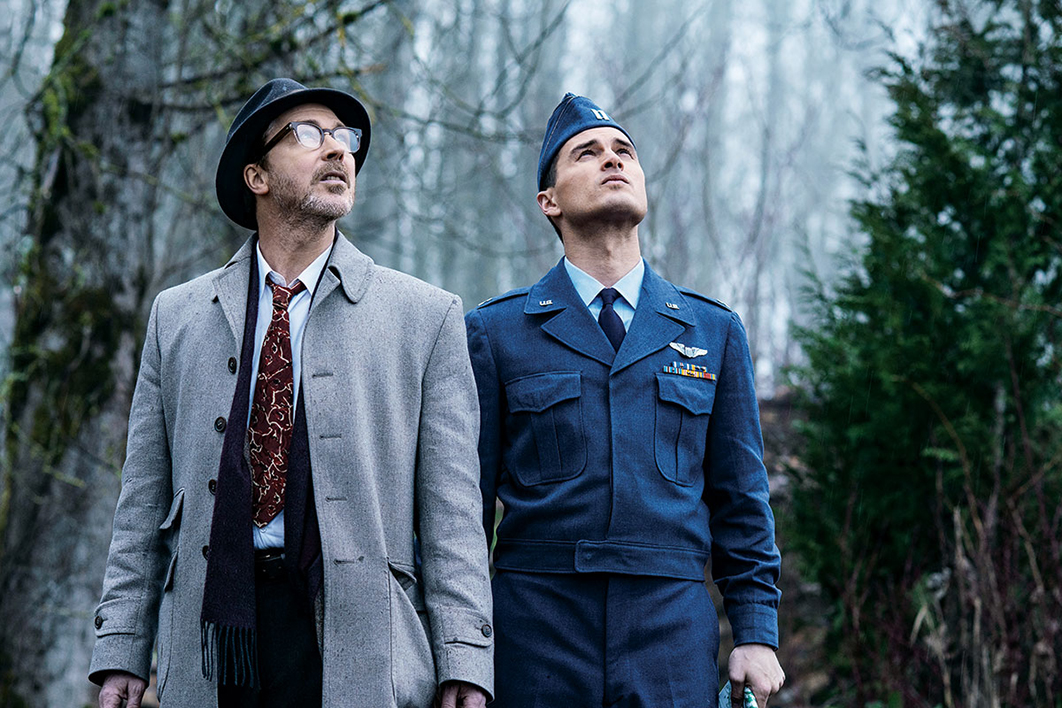The starfield stretches across the navigation monitors, desolate as ever, but this time there’s something in the foreground: a smudge of light indicating an object much closer. “That’s not our system,” says Officer Ripley.
This tightly focused scene at the start of Ridley Scott’s Alien (1979) heralds an unfolding horror story, the smudge on the radar looming closer and larger, then ever more monstrous. But if Alien represents one extreme of the observation-to-imagination ratio, the history of how US security officials have responded to UFO sightings is at the other: nothing to see here, and if you think otherwise then you are probably deluded, drunk or paranoid.
The Pentagon’s report on unidentified aerial phenomena, or UAPs — more popularly known as UFOs — released in June this year includes an image not unlike the one Ripley sees on her screen. It’s known to insiders as the Tic Tac video. The question is how far from such a manifestation we can legitimately take our speculations.
Highly anticipated, the report’s release has been accompanied by a spate of television dramas and documentaries about UFOs. The filmmakers don’t have much to go on: the Pentagon report is a long way from sensational reading. Of the 144 sightings deemed worthy of investigation, eighteen demonstrated movement or flight patterns that left unresolved questions. That’s about it. What caused some media excitement is the fact that the Pentagon had at last acknowledged that unexplained, and perhaps unexplainable, phenomena have indeed been detected in our skies and oceans.
These new programs tend to make the most of the “cover-up” side of the story, as the title of Netflix’s Top Secret UFO Projects: Declassified indicates. Although this series purports to be contributing to a newly enlarged view of close encounters, its relentless voice-over narrative and its mishmash of interviews and archival footage are stale and unpersuasive.
With little revelatory to offer — most of these accounts of sightings have already been widely circulated — the six episodes make for pretty tedious viewing. If anything, they perpetuate an ingrained problem with popular treatments of the UFO theme: by appealing to naive assumptions that all things hidden must be fascinating and all the most amazing things must be hidden, they damage the credibility of what evidence there is.
Australian journalist Ross Coulthart risks falling into the same trap with The UFO Phenomenon, a one-off 7NEWS Spotlight production that is the result, according to the publicity, of a two-year investigative journey across key American locations where sightings have been reported. The pitch is set in the opening frames. “This story will challenge your understanding of reality”; “The mainstream media wouldn’t touch it”; “We are at a turning point in human history.”
The Pentagon has made an unprecedented admission, says Coulthart: there is something in our skies that we — and more importantly, they — can’t explain. Cut to the seminal image of the blurry Tic Tac spot on the radar. Not our system? Despite its tendency to sensationalism, Coulthart’s version of the story has some advantages over its American counterpart. For a start, it’s shorter and more selective in its focus, concentrating on more recent events.
Coulthart wisely lets his interview subjects provide the bulk of the narrative. The conversations are filmed on location, notably in the spectacular remote landscapes of New Mexico, which seems to be a favoured site for visitations by alien craft. Stories of alien encounter come across so much better in settings that display the scale and strangeness of our own planet. With contributions from US navy commander Kevin Day, former deputy assistant defense secretary Christopher Mellon and Luis Elizondo, who headed the Pentagon Advanced Aerospace Threat Identification Program, Coulthart creates an effective reconstruction of the incident that began with the Tic Tac apparition.
So what are the legitimate lines of speculation to be drawn from this? Day provides a point-by-point account of the navigation patterns traced by his own reconnaissance pilot and the unidentified craft that was clearly responding to them. Elizondo offers a rapid inventory of capacities displayed by the Tic Tac: instantaneous acceleration, hypersonic velocities, low observability, trans-medium travel, anti-gravity. It is only through such detached, technical accounts that any real credibility can be established.
UFO historian David Marler refers to the tinfoil hat stereotype. The real cover-up story (well documented) was to encourage absurd popular culture stereotypes of little green men, flying saucers, bug-eyed gremlins, and the ominous officials in hats and overcoats reputed to pay a visit to people who report such things. Anyone who might be seeking to be taken seriously ran up against those cartoonish associations.
But the men in hats and overcoats were real enough. A US Air Force study in the 1950s and 60s, code-named Project Blue Book, was dedicated to suppressing and discrediting witness reports. Anyone making such a report was likely to get a knock on the door from its investigators. Project Blue Book, quite a story in itself, is dramatised in an American series of that name, currently in its second season on SBS.
The central character in Project Blue Book is J. Allen Hynek, a professor of astrophysics at Ohio State University and the Smithsonian Institution, who is enlisted to provide scientific explanations that will scotch any adventurous speculation from the press. Initially gratified by the role of “debunker for the air force,” the real-life Hynek gradually came round to a more qualified view, acknowledging that where reliable observers were involved, there were questions of scientific obligation and responsibility.
Hynek is played in the series by Aidan Gillen, who was superb as a smiling Machiavel in Game of Thrones. It should be good casting, just as the idea of a scientific expert who has to revise his most fundamental assumptions should provide a strong dramatic spine. But Project Blue Book is disappointing. The allusions to The X Files are obvious and overplayed, its sense of period too stylised and self-conscious, and it lacks pace and genuine psychological tension.
Which raises the question of why UFO stories are so hard to dramatise effectively. The X Files — with its blend of mystique and self-parody and some sophisticated on-screen chemistry between its charismatic lead actors — established a genre of which it remains the premier example. Perhaps the difficulty now is that the repertoire of stories and sightings is so drenched in retrospect. Close encounters seem to belong to a time when technologies were simpler and human understanding less constrained by advanced cosmology. Perhaps, after all, you do have to be a bit simple to swallow narratives about unexplainable phenomena.
The French series UFOs, also showing on SBS, certainly adopts that premise. Set in 1978, it gets some comedic mileage out of a plot involving a space engineer who, when his career goes off the rails, is invited to redeem himself by heading a UFO investigation unit. As he comes to terms with the hokey organisation to which he’s been assigned, with its hippy assistants and metal cabinets full of hard-copy files, the series works fairly well as a situation comedy. The UFOs remain essentially what the Pentagon was determined to make them — a silly story. •




